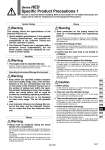
7-p1423-1439-hed_en 16 / 18
10秒後にBOOKのページに移動します
Series HED Specific Product Precautions 1 Be sure to read this before handling. Refer to front matter 41 for Safety Instructions and pages 1246 to 1249 for Temperature Control Equipment Precautions. System Design Warning This catalog shows the specifications of the Chemical Thermo-con. 1. Check detailed specifications in the separate “Product Specifications”, and evaluate the compatibility of the Chemical Thermo-con with the customer’s system. 2. The Chemical Thermo-con is equipped with a protective circuit independently, but the whole system should be designed by customer to ensure safety. Handling Warning 1. Thoroughly read the Operation Manual. Read the Operation Manual completely before operation, and keep this manual available whenever necessary. Operating Environment/Storage Environment Warning 1. Keep within the specified ambient temperature and humidity range. Also, if the set temperature is too low, condensation may form on the inside of the Chemical Thermo-con or the surface of piping even within the specified ambient temperature range. Dew condensation can cause failure, and so must be avoided by considering operating conditions. 2. The Chemical Thermo-con is not designed for clean room usage. The fan will generate dust. 3. Low molecular siloxane can damage the contact of the relay. Use the Chemical Thermocon in a place free from low molecular siloxane. Piping Warning 1. Piping must be designed taking the whole system into consideration. For this product and future equipment, design of the piping system should be performed by a knowledgeable and experienced person. The fitting is not attached, and should be prepared separately by customer. Select a fitting suitable for the material and dimensions of the tube. When connecting the fitting, use a specific tool specified by fitting manufacturer. Warning Caution 1. Before piping Confirm that dust, scales etc., in contact with piping is cleaned up or air blown (flushing) before piping. 2. Take care over the direction of fluid. Do not mistake the direction of “IN” and “OUT” for the facility water system and circulating fluid system. 3. Take countermeasures against condensation. Depending on the operating condition, condensation may occur on the piping. In such a case, take countermeasures such as installing insulation material, etc. 4. Avoid electrostatic discharge. If a fluid with low conductivity such as deionized water is used as the circulating fluid, static electricity generated by flow friction may be discharged to the temperature sensor and malfunction the Chemical Thermo-con. Consider measures to minimize the discharge of static electricity from the circulating fluid to signal line including the temperature sensor. For example, a PFA conductive tube or metal piping (metal flexible hose) can be used to provide grounding to the piping of the external sensor and to discharge. 2. Work performed on the piping should be done by a knowledgeable and experienced person. If work performed on the piping is done by a less knowledgeable and inexperienced person, it will likely lead to operating fluid leakage, etc. 3. Confirm the leakage of fluid. Fluid leakage can cause dangerous accidents. Be sure to confirm that the hose or tubing is not pulled out and that there is no leakage in the fitted parts. 4. Confirm that the resin tube is not kinked or collapsed. If a resin tube is used, it should be checked for the presence and possibility of kink or collapse. 5. Countermeasures against fluid leakage Water drops may accumulate due to leakage of circulating fluid or facility water, or condensation on the piping. Install the Chemical Thermo-con with a drip pan, fluid leak sensor and exhaust system. If leakage is detected, cut off the circulating pump with a hardware interlock, and cut off the power to the Chemical Thermocon. Depending on the type of chemical used (circulating fluid), it may have a harmful effect on the surrounding equipment and the human body. Piping 1437 HRG HRS HRZ HRZD HRW HEC HEB HED HEA IDH